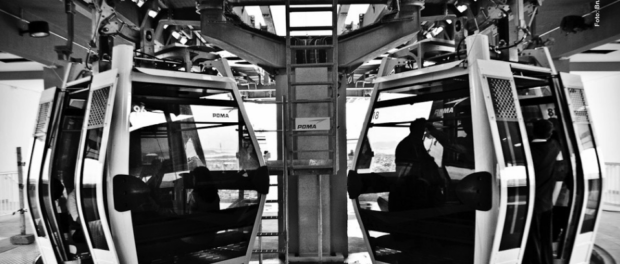
For the original in Portuguese, published in Voz das Comunidades, click here.
Every day the favela develops, and the needs of its residents develop along with it. One of these needs is the means of transport. The presence of vans and motorcycle taxis is now common in the favela communities of Rio de Janeiro. In Complexo do Alemão, for example, these methods of transportation are already part of the community’s environment, in addition to the cable car which has recently solved the problem for many residents.
General services assistant Ana Lucia Santos Silveira always uses the kombi (VW van) and says it makes her life much easier: “When I’m carrying a heavy bag or when I’m tired, it’s much better to take a van because it drops me off at the entrance of the villa where I live.”
“The kombi is the favela’s ambulance,” says kombi driver Carlos Alberto Cruz, better known as Camarão (Shrimp). He says he always assists residents who are sick and has been doing so for a long time. Camarão has worked as a driver for 11 years and is proud of what he does. He asserts there is work for everybody, as passengers are very frequent.
Maria Luciana dos Santos Gomes, a housekeeper, has just traveled on the cable car and approves of these various means of transport. She says that not everyone is physically capable of climbing the favela’s stairs, particularly the elderly, but criticized the behavior of some van drivers: “Sometimes they take a while to leave [the kombi stop]. For example, in the Inhaúma stop the kombi leaves even when there are seats remaining but this doesn’t happen in Nova Brasília [where] they always wait until the kombi is full.”
Social worker Luciene Silva dos Santos prefers the motorcycle taxi service. According to her, riding on a motorcycle is the best option due to the speed, convenient schedule, and flexible routes. Luciene says many drivers are helpful and end up providing other services aside from just passenger transportation. “I’ve become friends with them, sometimes they’ll buy bread, medicine, and even pay the bill.” But she also points out that motorcycle drivers are often discriminated against due to the fact they are not legalized and due to the bad behavior of some, mostly young motorists who drive at high speeds.
“Working in motorcycle taxis is my life and I do it because I like it,” says moto-taxi driver Cristiano Alves, who is employed by a newspaper in the early mornings and works as a moto-taxi driver during the day in Complexo do Alemão.
Maria Ângela, a housewife, uses the cable car and says this transport has helped her immensely, as she lives in Morro das Palmeiras and works in Saracuruna. Before, Maria descended the hill and walked 10 to 15 minutes, took a bus to Bonsucesso and then the train. This route used to take her an hour and now it takes her only 20 minutes. The housewife lamented that the last station is only at Morro das Palmeiras. For Maria, the cable car should extend to the Manha community, because many residents still need to climb the hill to reach the station and end up using a motorcycle taxi, which to her is a means of transport that is quick but very dangerous.
